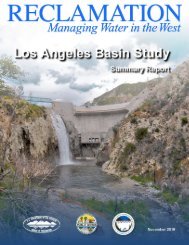Subsurface Iron and Arsenic Removal
qj78kp8
qj78kp8
- No tags were found...
You also want an ePaper? Increase the reach of your titles
YUMPU automatically turns print PDFs into web optimized ePapers that Google loves.
<strong>Subsurface</strong> iron <strong>and</strong> arsenic removal for drinking water treatment in Bangladesh<br />
2<br />
[PO 4<br />
-3 ] in mmol.L-1<br />
0.05<br />
0.04<br />
0.03<br />
0.02<br />
0.01<br />
0<br />
0<br />
0 100,000 200,000 300,000 400,000<br />
0.1<br />
0.08<br />
0.06<br />
0.04<br />
0.02<br />
[As] in µmol.L -1<br />
did not exceed 0.01 mmol.L -1 , which is far below the<br />
concentrations measured during cycle 1 (Figure 2.10).<br />
<strong>Arsenic</strong> concentrations remained below 0.1 µmol.L -1<br />
<strong>and</strong> were thus also not found to remobilize after SIR<br />
was stopped at WTP Lekkerkerk.<br />
Pumped volume (m 3 )<br />
Conclusions<br />
Phosphate <strong>Arsenic</strong><br />
Figure 2.13 Phosphate <strong>and</strong> arsenic measurements once subsurface<br />
iron removal had stopped after 18 injectionabstraction<br />
cycles (WTP Lekkerkerk)<br />
suddenly change (e.g., pH), which is not likely in a<br />
normal well field. Exchange of the adsorbed anion with<br />
other passing anions with higher affinity could promote<br />
the release of retained arsenic or phosphate from the soil<br />
grain surface. However, once groundwater conditions<br />
stabilize around the stopped SIR well no large water<br />
quality variations are expected. Re-crystallization<br />
of (amorphous) iron or manganese oxides to oxides<br />
of higher crystallinity is a slow process, but could<br />
release small amounts of trace elements. Although<br />
Figure 2.13 shows some variations in the arsenic <strong>and</strong><br />
phosphate concentrations, it is obvious that high peak<br />
concentrations are not observed. It may be concluded<br />
that the retained phosphate was not mobilized to<br />
elevated solute concentrations once injection was no<br />
longer applied. Phosphate concentrations generally<br />
During subsurface iron removal at WTP Lekkerkerk,<br />
iron, manganese, phosphate <strong>and</strong> arsenic were measured<br />
to be retained in the aquifer at varying efficacies. SIR<br />
technology was found to improve in efficacy with<br />
every successive cycle, which correlates well with<br />
findings in other literature. No peak concentrations<br />
of the studied constituents were observed in the<br />
abstracted groundwater once SIR was stopped <strong>and</strong><br />
therefore not threatening the sustainability of the<br />
groundwater production well. pH was shown to be the<br />
most pronounced water quality parameter determining<br />
the efficacy of SIR, the operational V/Vi ratio more<br />
than doubled between pH 7.0 <strong>and</strong> 7.4 at WTP Corle.<br />
The experiences in the Netherl<strong>and</strong>s have shown<br />
that subsurface iron removal is an effective, robust<br />
<strong>and</strong> sustainable iron removal technology with great<br />
potential for worldwide application.<br />
34



